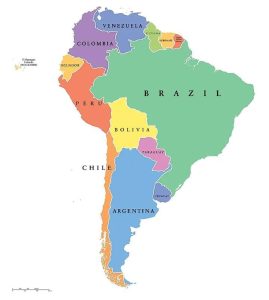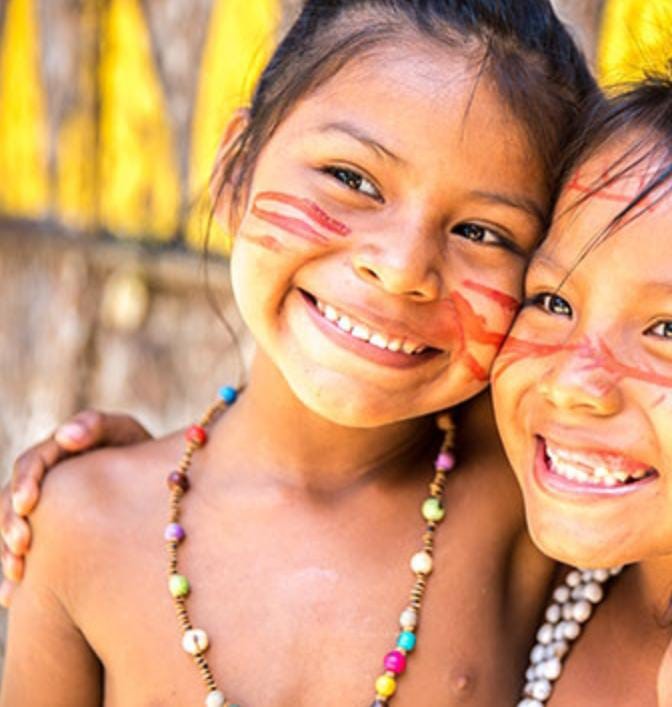South America has 12 countries and two dependencies, with over 433 million people. Most countries in the region speak Spanish, but some countries like Brazil speak Portuguese, Suriname is Dutch, French Guiana is French, and Guyana and Falkland Island are English.

The region has breathtaking landscapes and a mosaic of cultures that hold a fascinating tapestry of greetings that reflect its diverse history and geography. The cultural tapestry of South America is woven with threads of indigenous heritage and colonial legacies. Pre-Columbian civilizations like the Inca, Aztecs, and Maya once thrived here, leaving archaeological wonders such as Machu Picchu and the Nazca Lines. Spanish and Portuguese colonial rule significantly shaped the continent’s culture and languages.
Today, South America celebrates its mestizo heritage, a blend of indigenous and European ancestry, alongside vibrant indigenous communities preserving their traditions. With its diverse cultural heritage, South America is a fascinating region to explore regarding greetings. From Brazil’s warm embraces to Argentina’s formal handshakes, the continent has unique greetings that symbolize its rich cultural diversity.
Understanding the Importance of Greetings in South America
Greetings hold immense significance in South American societies. They serve as a foundation for social interactions. They establish a sense of respect, politeness, and inclusion among individuals. When South Americans greet one another, it goes beyond merely exchanging pleasantries; it reflects their hospitality, warmth, and community values.
The Role of Greetings in Social Interactions
In South America, greetings are essential in formal and informal settings, reflecting the region’s emphasis on social harmony.
When two people meet in South America, it is customary for them to greet each other with a warm smile and direct eye contact. This initial interaction sets the tone for the conversation that follows. They engage in small talk during greetings, asking about each other’s well-being, family, and recent activities. This exchange of pleasantries helps to establish a friendly and open atmosphere, making both parties feel comfortable and valued.
In formal settings, such as business meetings or official events, greetings in South America often involve a handshake. This gesture signifies respect and professionalism. It is important to note that the strength of the handshake should be moderate, neither too firm nor too weak. A firm handshake is seen as confident and respectful, while a weak handshake may be perceived as disinterest or lack of enthusiasm.
On the other hand, informal greetings in South America can be more affectionate and intimate. It is common for friends and family members to greet each other with hugs and kisses on the cheek. These physical displays of affection symbolize the close bond between individuals and reflect the warmth and closeness South Americans value in their relationships.
The Influence of Indigenous Cultures on Greetings
South America’s indigenous cultures have significantly influenced greetings in the region. These greetings often involve physical contact, such as hugs, kisses, or handshakes. They establish a connection and convey respect. Indigenous languages and gestures are incorporated into greetings, preserving cultural traditions and honoring ancestral heritage.
For example, in some indigenous communities, greetings may involve the exchange of traditional blessings or prayers. These rituals are deeply rooted in spirituality and invoke positive energy and well-being. By incorporating these elements into greetings, South Americans pay homage to their indigenous roots and maintain a solid connection to their cultural heritage.
Furthermore, indigenous languages play a significant role in greetings across South America. In addition to the widely spoken Spanish and Portuguese, many indigenous languages are still spoken and used in daily interactions. When greeting someone from an indigenous community, it is considered respectful to learn and use basic greetings in their native language. This gesture shows appreciation for their culture and fosters a sense of inclusivity and understanding.
A Closer Look at Greetings in Different South American Countries
Brazil
Brazil, known for its vibrant culture and spirited people, has diverse greetings. The most common greeting in Brazil is a warm hug or a kiss on both cheeks, regardless of familiarity. This affectionate gesture reflects the Brazilians’ welcoming and inclusive nature, making visitors feel instantly welcomed by the local community.
Argentina
Argentina has a more formal approach to greetings. Handshakes are the customary way to greet both friends and strangers. Argentinians take pride in their politeness and adhere to proper etiquette, emphasizing respect and professionalism. However, friends and family greet each other with a kiss on the cheek.
Peru
Peru, well-known for its ancient civilizations and splendid landscapes, celebrates its diversity through greetings. Peruvians often greet one another with a handshake, followed by a cheek kiss. Moreover, they use culturally specific terms, such as “Buenos Días” (Good Morning) and “Hola!” (Hello), to acknowledge the unique characteristics of their regions.

The Impact of Greetings on Cultural Diversity
Greetings as a Reflection of Cultural Identity
The various forms of greetings in South America showcase the continent’s multicultural tapestry and the historical influences shaping each nation’s distinct customs. Greetings celebrate diversity and help preserve cultural diversity and heritage in an ever-changing world.
How Greetings Foster Cultural Understanding.
Individuals foster cultural understanding and promote empathy by understanding and appreciating the different greetings in South America. Learning about these diverse greetings encourages people to explore the complexities of different cultures, values, and histories. It enables meaningful connections that transcend language barriers and create shared experiences.
The Evolution of South American Greetings
Historical Influences on South American Greetings
The evolution of South American greetings is intertwined with its dynamic history. The influence of colonization, immigration, and cultural exchange has shaped how people greet one another. The melding of indigenous traditions and the arrival of European customs resulted in the unique blend of greetings seen across the continent today.
Modern Adaptations of Traditional Greetings
In the contemporary world, South American greetings have evolved and adapted to changing lifestyles and cultural dynamics. While traditional greetings remain at the center, global influences and local practices are now fused. For instance, younger generations in urban areas may incorporate elements of Western-style greetings while retaining traditional aspects to form their distinct greetings.
The Future of Greetings in South America
Preserving Cultural Diversity through Greetings
As South America faces globalization and rapid societal changes, preserving cultural diversity becomes increasingly important. Greetings serve as a potent tool for safeguarding traditions, as they are deeply rooted in the fabric of society. By cherishing and perpetuating these unique greetings, South Americans can ensure the continuity of their rich cultural heritage.
The Role of Greetings in a Globalized World
In a globalized world, greetings hold the potential to bridge cultural gaps and foster global understanding. With their authenticity and charm, South American greetings have the power to captivate people from diverse backgrounds. They serve as an invitation to explore the continent’s cultural diversity and form connections that transcend boundaries, enriching the lives of individuals and communities alike.
Conclusion
South American greetings serve as gateways to understanding the rich cultural tapestry of the continent. These gestures embody respect, warmth, and diversity, echoing the values of each nation. From Brazil’s affectionate hugs to Argentina’s formal handshakes and Peru’s diverse salutations, these greetings reflect historical influences, indigenous roots, and evolving societal norms.
These greetings bridge individuals and communities as connection threads, fostering unity and empathy. They symbolize cultural identity, with indigenous languages and customs seamlessly integrated. By embracing these diverse ways of greeting, people promote cultural understanding and celebrate the unique heritage that shapes South America.
In the ever-changing world, these greetings remain vital links to the past, adaptive to modern dynamics while honoring tradition. They encapsulate the essence of South America’s cultural journey, harmonizing the old and the new in gestures that signify more than words.






